What the FAQ: Dental Care Answered
Q: Why is dental care for dogs and cats important?
A: Just like human beings, your pets get the same bacteria-filled plaque build-up on their teeth each day that can turn into tartar if it is not promptly removed. Tartar holds onto a lot of bacteria that can damage and inflame the gums, possibly causing tooth loss, and even infecting a pet’s internal organs, which will mean pain for your pet and expensive vet bills for you.
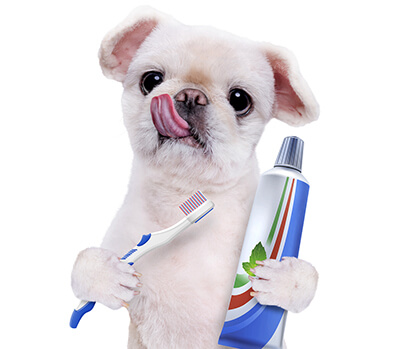
Q: Do dogs and cats need the same sort of dental cleaning?
A: Yes, they do. The thing to keep in mind about dogs and cats is that they will both need regular dental care. Overall, every pet needs the same dental care, but because they each have unique anatomies and concerns, it is important that they are being treated by a vet with knowledge of specific diseases who can identify them in different species. This includes feline stomatitis, feline tooth resorption, and oral cancers.
Q: How often should my pet get their teeth cleaned?
A: Cats and dogs need to have dental cleanings once a year beginning around age two. If they have oral health issues that have been identified earlier than that, then they should begin getting cleanings before the age of two. Pet owners should also be brushing their pet’s teeth every day in between these professional cleanings to protect their dental health.
Q: When my pet goes for their dental checkup, is anesthesia really necessary?
A: It is. In most cases for dental appointments, the vet uses a stringent anesthesia protocol identical to the type used for surgery. Even pets that are on their best behavior cannot keep themselves totally still for these sorts of appointments. Because vets use sharp dental tools to clean the teeth and remove tartar, pets can become injured if they are not under anesthesia and lying perfectly still.
Q: Is using anesthesia for dental cleaning a safe practice?
A: By using the right anesthesia protocols and by having a trained anesthetist monitor the process at a veterinary hospital, anesthesia for pets is totally safe. To learn more about safe anesthesia of pets, contact your veterinarian with questions.
Q: What is the difference between a dental cleaning for my pet at an anesthesia-free clinic and at the vet’s office?
A veterinary cleaning will involve not only a cleaning but also a total oral examination by the vet. They will clean above and below the gums and will take x-rays of the mouth. That said, an anesthesia-free dental clinic would perform non-veterinary procedures where the pet is instead put in restraints and remains awake. Furthermore, the visible aspect of their teeth is scraped, but this does not clean the teeth thoroughly, leaving your pet at risk for the progression of existing oral diseases and other issues.
Q: Why are pet dental cleanings at my vet more expensive than anesthesia-free procedures done by my groomer?
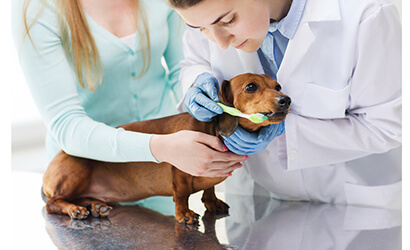
A: To put it simply, when it comes to the procedure itself, just like anything else, you are getting what you pay for. A vet will provide you with a professional service that is backed by experience and training and does so with your pet’s health in mind. There are naturally going to be higher costs that come with a trained staff, x-rays, anesthesia, and equipment. These all amount to giving your pet the highest quality of care and health. Over the long-term, treating dental disease because a pet doesn’t have thorough dental cleanings due to lack of anesthesia means that your pet’s care will ultimately become more expensive.
Q: Will my pet need to have antibiotics for their appointment for dental work?
A: Not typically. The vet usually only gives antibiotics to pets that have health conditions that may cause a weak immune system. Most healthy pets will not need antibiotics before a dental appointment.
Q: What does it mean when a tooth has changed color?
A: If the tooth turns from dark pink to purple or black, this means that the tooth is either dead or dying. Medication can also cause discoloration, and these teeth are not dying, but the staining can be permanent. If you notice discoloration of your pet’s teeth, ask your vet to examine it.
Q: Why does my pet’s breath stink?
A: Bad breath can be a sign of disease, usually oral disease; it does not just mean that their teeth are dirty. Halitosis, or bad breath, can often serve as an indicator that periodontal disease is present. This disease sits beneath the pet’s gums and can eat away at oral tissue, bone, and tooth structure. Severe periodontal disease may affect other organs as the disease progresses, including kidneys, the liver, and the heart.
Q: Can my pet get cavities?
A: Cavities are rare in cats and dogs, but pets that have had their teeth neglected can develop diseases like gingivitis, periodontal disease, abscesses, and tooth loss.
Q: My pet seems to have fractured his tooth but is not showing symptoms of pain. Should I get this tooth fixed?
A: Even if they are not exhibiting signs of pain, the pain will come later. This is because the bacteria will get into the crack in the tooth and affect the root system which leads right to the jawbone. This is very painful and can result in not only further infection but in tooth loss as well. Getting it treated quickly will prevent your pet from having pain and will reduce the cost of having to treat a more severe issue later on.
Q: When does my pet need to have a tooth extracted? Is it really necessary?
A: When the pet’s tooth becomes so severely infected that it begins to threaten the tissues surrounding the tooth, removing the tooth is the best option. This is to help save not only the other teeth but to protect the tissues and gums as well. Vets always opt for the least drastic and invasive procedures when they can, but it really comes down to the pet’s long-term well-being and overall health.
Q: Can my pet eat crunchy treats or food right after a dental extraction?
A: Eventually they will be able to. Pets will usually need around two weeks of only eating soft food so that the tissue is able to heal properly. After this amount of time, your dog or cat should be able to eat normally because they won’t be in pain once the infected tooth has been removed.
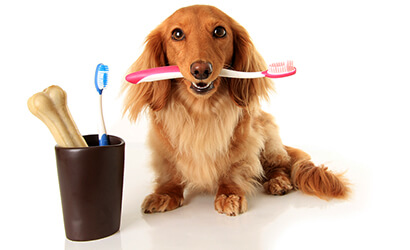
Q: How often do I need to bring my pet in for professional dental cleaning?
A: Most household pets will benefit from a professional dental cleaning once a year under general anesthesia. In some cases, more frequent treatment may be needed. It is important to talk to your vet or the vet’s dental specialist to understand the right oral health care plan for your pet. In order to have a proper assessment of your pet’s oral health, this procedure should include an oral exam or full-mouth or regional x-rays, all under general anesthesia.
Q: How will I know if my cat or dog has dental problems or gum disease?
A: Ask yourself the following questions:
- Does your cat or dog have bad breath all of the time?
- Does your pet avoid you touching around their mouths?
- Does your pet have excessive drool or often drop food from their mouths?
- Does your pet’s mouth bleed?
- Have they experienced weight loss or a loss of appetite?
If your pet will let you, open its mouth and look around inside. Check for the warning signs of gum disease. These include swollen and red gums, a yellow-brown tartar crust around the gum line, and bleeding or pain when you touch their mouths or gums. You may also want to look for tartar, discoloration, and loose, missing, or broken teeth.
If you notice any of these symptoms, contact a vet. Dental disease will progress, but if you catch it early, you can stop any further damage while saving as many teeth as possible. Getting the teeth professionally examined will help decide if you need a cleaning or other dental work for your pets.
Q: What is a Board Certified Veterinary Specialist?
A: Veterinary medicine and an increasingly important role of pets in society have resulted in the emergence of a number of veterinary specialties comparable to those in human medicine such as surgeons and cardiologists. Dentistry is one of over 20 specialties that are actively recognized by the AVMA, or the American Veterinary Medical Association.
To get a specialty certification, a person must complete 3 to 6 years of training in the specialization area that goes beyond the DVM, or Doctor of Veterinary Medicine degree. Requirements can vary among individual colleges, but all professionals must pass advanced requirements approved by the AVMA. Alongside the training in their specialized field, a vet must submit credentials of their expertise to a review board through their specialty school. After the credentials have been accepted, they must then take an extensive practical and written exam in order for their certification to successfully be completed and to become a specialist.
Once these requirements have been achieved, the candidate will then be called a Board Certified Specialist from the specialty school. Vet dentistry candidates who have completed the process can use the titles Veterinary Dentist and Veterinary Dental Specialist, Board Certified Veterinary Dentist, or Diplomate of the American Veterinary Dental College.
Q: What are some of the common signs of dental disease in animals?
A: Signs of dental disease, or periodontal disease may include any of the following symptoms:
- Unwillingness to play with their toys
- A lack of appetite
- Unwillingness to eat or drink
- Releasing food from their mouths
- Drooling excessively
- Swelling under their eyes
- Lethargy or slowing down
- Appearance of dental tartar or plaque
- Bad breath
- Chattering teeth
- Tooth loss outside of the normal loss of baby teeth
- Broken or discolored teeth
- Rubbing or pawing at the face
- Avoiding your touch of his or her face or mouth
Q: How do I go about brushing my pet’s teeth at home?
A: In order to brush your pet’s teeth, you are going to need to train your pet very slowly over the course of a number of weeks. Small cats and dogs are easiest to do when they are sitting on a surface, on your lap or on the counter. A bigger dog can have their teeth brushed sitting on the floor. When you first start training them, it might take two or more people to complete the job. Just be sure that you are not over-restraining the animal and that you keep these sessions positive and short lived. One person should be holding the pet while the other one is doing the brushing. Reassure your pet and praise them while you work. At the end of the session, give them a treat or some other reward.
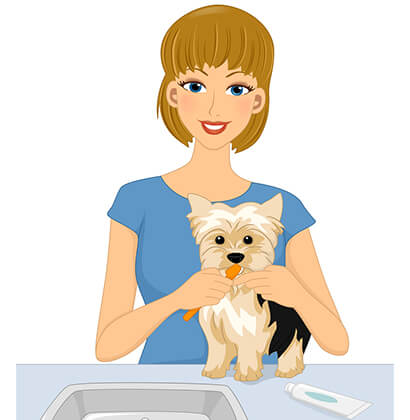
To begin:
– Dab a little bit of flavored toothpaste that can be found at a pet store onto your finger. These toothpastes will generally come in beef or chicken flavor. Standard toothpastes for humans may upset your pet’s stomach, so avoid those. Rub the finger with the toothpaste over the pet’s mouth and teeth to get them used to it. Don’t prolong this process the first few times.
– Over time, introduce the gauze over your finger and gently begin scrubbing the gums and teeth in a circular motion.
– After the gauze, you can introduce a soft, pet-specific toothbrush. These special pet toothbrushes can be found at a pet store or at your vet’s office.
If your pet does not want to cooperate and you are unable to brush their teeth at home, or if you are already noticing brown tartar stains on their teeth or bleeding or red gums, it is time to go to your vet dentist for help. Once there, your pet will be given anesthesia and will have their teeth cleaned both below and above the gum line in order to remove any tartar or plaque. After their teeth have been cleaned, they will then be polished in order to remove any microscopic plaque, along with making the teeth smoother to help ward off plaque from accumulating.
Q: Putting my pet under anesthesia scares me. Aren’t they too old for that?
A: While the risk of putting a pet under anesthesia may be increased slightly for older animals because of the usual aging of their organs, age isn’t considered a disease and shouldn’t be one of the reasons that you avoid dental treatments. Vets will perform a physical exam before they put them under anesthesia to ensure that your cat or dog has both a healthy set of lungs and a healthy heart. Blood work is sometimes recommended before the treatment to check other internal organs. Even if your pet does have health problems, anesthesia can still be employed safely to give them outstanding dental care. The risk of pet death by anesthesia-related complications is much lower than 1 percent. The benefits of a healthy mouth free of pain far outweigh the small risk of anesthesia.
Q: How long will a dental cleaning last for?
A: Dental cleaning will usually take somewhere between 45 to 75 minutes. This timeframe will depend on the amount of tartar that is present, the dental disease that is present, and finally the number of dental x-rays that need to be taken. Dental extraction will usually take somewhere between 1 and 2.5 hours.
Q: Are there any risks associated with dental extractions, cleaning, or anesthesia?
A: Your vet will take every precaution to prevent any complications by performing a physical examination and extensive lab testing, and implementing strict monitoring of the patient to reduce these risks. Risks can never be fully eliminated, but your vet does everything they can to help reduce the chances of a negative result or complication.
Q: When will antibiotics be needed for dental procedures?
A: After the routine scaling of teeth, most patients will go through a transient bacteremia, which just means that there are bacteria in the bloodstream. In a healthy pet, their immune system will kill those bacteria and it will decline without the use of systemic antibiotics. For animals that have existing systemic disease such as kidney, liver, or heart disease, or are immunocompromised, antibiotics will be issued. These high and moderate risk patients will get antibiotics for about one hour before their dental procedure.
Q: Why is having recent blood work important?
A: Vets use blood work to look for underlying diseases and organ dysfunction before they employ an anesthetic procedure. Having a physical exam by itself may not show these underlying diseases. It is recommended that all patients who are coming to their vet for a dental cleaning procedure have blood work done before they have dental treatment. The pre-op blood work will check blood sugar levels, and kidney and liver functions. It will also check for signs of dehydration, anemia, and infections.
Q: Are there other alternatives to extracting my pet’s teeth?
A: Occasionally there will be other ways to treat a tooth beside extracting it. Some teeth that are broken or abscessed can have a root canal performed on them or have crowns put on them. Because this type of work is not performed in a vet office clinic, these procedures are often performed by a board certified veterinary dentist who will be recommended by your veterinarian. It will be more expensive than simply extracting the tooth, but it is an option in a few cases.
Q: What are some other treatments for oral diseases?
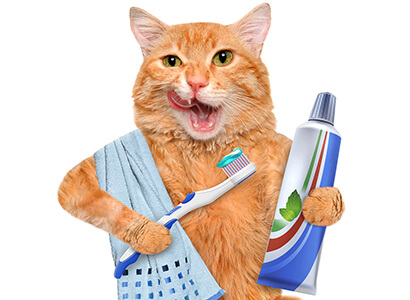
A: When periodontal disease does not get treated, it can lead to tooth loss. Many patients are surprised when a vet recommends that a tooth is extracted, and while it may seem drastic at first, it isn’t. It seems only seems drastic because people equate their own experiences with dental care to those of their pets. With pets, when periodontal disease has been detected in a severe or advanced stage and large amounts of tooth tissue or bone have been lost by the teeth’s roots, the options for saving their teeth are few. Extracting the tooth is usually the only way to get their oral health back to normal. If the tooth that is diseased is not treated or pulled out, the teeth around it may become compromised as well. There are other treatment options when this disease has been detected early. These are usually completed by board-certified veterinary dentists and involve guided tissue and bone regeneration, ridge augmentation, or bone grafting to treat periodontitis with surgery.
Q: Is dental scaling done on animals without anesthesia a realistic alternative to periodontal therapy done professionally?
A: Animals often do not receive the same type of dental hygiene at home that humans do. Because of this, adult pets will often have periodontal disease. In many of these pets, mostly senior animals, periodontal disease will have progressed passed its early stages. They will usually require surgery of some sort along with dental scaling. When scaling is used as a treatment, especially when used as the sole treatment of the disease, it is cosmetic and does not provide therapy.
Naturally, pet owners become concerned with they must put their pets under anesthesia. That said, performing dental scaling on a pet that has not been anesthetized is not wise. This is because:
– Dental tartar is stuck firmly onto teeth. Dental scaling to get this tartar off is done by using sonic power and ultrasonic scalers along with hand instruments with a sharp edge. Even the slightest movement of the patient’s head could end up causing injury to the oral tissues of the patient, and the person doing the scaling could be bitten as the patient reacts to the injury.
– Professional dental scaling will also include the scaling of the surfaces of the teeth below and above the gum line. Dental polishing will then follow. The most crucial aspect of dental scaling is scaling the tooth areas that are around the gingival pocket, which is the space between the root and the gum. This is where the disease is active. Because the human patient will cooperate during this procedure, dental scaling of human teeth can be done without anesthesia. Because access to the area below the gum line without anesthesia is impossible for pets, they must be anesthetized. Removal of the tartar on the teeth will have little effect on the health of the pet and will only be for cosmetic purposes.
– The pet inhaling the anesthesia through an endotracheal tube will provide three crucial benefits: elimination of the pain that results from the exam, treatment of the dental tissue while the procedure is happening, the cooperation of the animal receiving a procedure that it cannot understand, and the protection of the lungs and airway from accidental choking. The ACVAA, or the American College of Veterinary Anesthesia and Analgesia, recommends general anesthesia with intubation of an endotracheal tube with all dental cleanings for cats and dogs.
– A wholly completed oral exam, which is imperative when the professional dental scaling is occurring, isn’t possible when the pet is not under anesthesia. The surfaces of the teeth that are near the tongue won’t be able to be examined, making areas of discomfort and disease hard to address.
Q: Isn’t my dog too old to go under anesthesia?
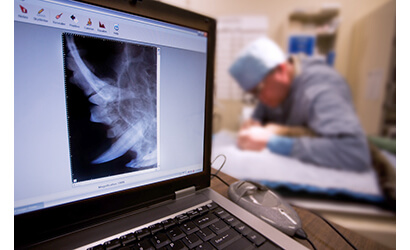
A: Many pet owners are concerned about their pets undergoing anesthesia because another vet may have told them that their pet is past the "safe age" for anesthetics. Age doesn’t reflect the status of your pet’s health. Just as there are older people in good health and younger people in poor health, the same can be said for pets. Doctors prefer to evaluate every pet as an individual to address their health status and make this decision for anesthesia based on the pet’s health. Potential health problems are addressed with anesthesia protocols. Doctors will choose anesthetic drugs based on the health of the pet in order to avoid any problems. Luckily, patients who have health problems are able to get anesthesia and dental care too. The risks that come with anesthesia are reduced by the professionals giving your pet dental care. The risk for anesthetic-related deaths for pets is less than one percent.
Q: Is dental treatment painful after it has been completed?
A: Extracting a tooth can indeed be painful for a pet, but the vets you go to will keep your pet as safe as possible before the procedure, while the procedure is happening, and after the procedure as well. Animals that have a dental procedure will always get an injection of pain relievers both before and after the procedure takes place. It will happen after surgery as well, and oftentimes pets will be sent home with pain medication too.
Q: Does my pet need a specified vet dentist?
A: Most vets will be able to perform general dental exams, tooth extractions, and teeth cleaning. A veterinary dentist is going to have a board certification in dentistry and will have completed a number of other training programs. Since the vet dentist will have been trained in oral surgery, dentistry, and medicine, a huge range of treatment options are available to your dog and cat. In some cases, a vet dentist will give you alternatives to extracting a tooth that aren’t available at your standard vet’s office.
Q: My pet doesn’t seem to be in pain. How will I know they are having oral problems?
A: Pets with painful issues in their mouths will not often show signs of pain. This, of course, does not mean that they aren’t feeling it, but instead, it means that they aren’t behaving in ways that a human would recognize as pain-based. Studies show that cats and dogs have the same sense of pain as humans do. It is thought that in the wild, if an animal shows a sign of weakness, it can be negative for them, and therefore they hide these signs of illness. It is likely that cats and dogs that have been domesticated still possess this instinct to hide their "weaknesses." Since this painful condition will come on gradually, most pet owners who have pets with a painful mouth will think that their pet is just showing their signs of aging and acting grumpy. When the condition has been treated, the improvement will be noticed quickly. Many pet owners will think that their pet is acting much younger after their treatment. The most common reason that a cat or a dog will act older is due to the pain in their mouths. When it’s gone, so is the "aging" act.
Q: If dental problems are so frequent and common with household pets, why aren’t they seen out in the wild?
A: Dental problems happen quite frequently with wild animals as well. Studies done on the skulls of African Wild Dogs’ skulls that are over a century old have shown that similar types of dental problems have occurred within similar species forever. Do remember that these wild animals will have only lived to be a couple of years old, while domestic cats and dogs that get treated will live into their teen years. Wild animals will not have as much of a chance to outlive their dental problems, while domestic animals will live long enough to have these problems. It makes quite a difference.
Q: Why does my pet still have dental problems even though I only feed them dry food?
A: Anything that increases action inside of the mouth will benefit them, but only feeding dry food has only a small effect when it comes to preventing oral issues. If you only ate dry food but neglected to brush your teeth or have them cleaned, you would still develop issues with your mouth. Some dry foods are formulated to have a significant effect when it comes to preventing problems with teeth.
Q: Are there any diets in particular that can help to improve the oral health of my pet?
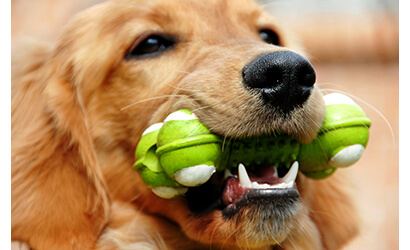
A: There are dental diets that have been specially designed to help stop the tartar and plaque build-up between the cleanings of your pet’s teeth. These may even extend the time that is needed between cleanings. Not every product with a dental claim on their packaging is going to be effective. It is important to inform yourself about the different types of dental food items. The Veterinary Oral Health Council, or the VOHC, is an independent organization that offers a seal of acceptance to different dental diets and other products that meet a certain standard in the reduction of tartar and plaque in pets.
Q: What do I do if I find that my pet has "double teeth?"
A: “Double teeth” occurs when the baby teeth are not shed as their adult, or permanent teeth, come out. The permanent teeth will usually emerge during the age of three to seven months. If the baby tooth does not come out in an orderly fashion, this will cause the permanent tooth to displace itself into a painful position. It may also cause the formation of infectious pockets at an early age. The baby teeth that remain will need to be pulled out by a dentist who can remove the entire root. There shouldn’t ever be two teeth in the same place simultaneously. If you think that your pet is experiencing double teeth, they need to be checked out by a dentist.
Q: My pet’s mouth has a swollen area. Should I be concerned?
A: Swollen areas in the mouth can be caused by a number of things. Several types of both malignant and benign tumors can occur in the mouth. The gums could even become overgrown for any number of reasons. A vet who is familiar with diseases of the mouth should check out and examine any enlarged areas, especially ones that continue to grow, are painful, are ulcerated, or are bleeding.
Q: Why should I try and save the teeth? Why not just have them pulled out?
A: If dental issues are detected early on, the teeth can be saved with only a little bit of treatment. Certain teeth are needed for chewing or for daily activities, so these are more crucial to keep maintained. Furthermore, taking out certain teeth requires aggressive bone removal which can remove or weaken the jawbone. Every patient and every tooth needs to be evaluated. The owner needs to be made aware of the options of treatment for each issue. Vet dentists deal Improving health and reducing discomfort.
Q: Are gums that are red an indication of oral or dental issues?
A: Gingivitis, or reddened gums, is not an issue alone, but can be associated with periodontal disease. Since it is hard to tell which cases of gingivitis will end up turning into periodontal disease, vets consider a red stripe along the gum a reason to perform a dental cleaning procedure. Should periodontal disease exist, causing injury or damage to the structures of their teeth and gums, this will be noted and it will be treated the appropriate way. The patient will be put under anesthesia in order to do this.
Q: Should my pet have regular checkups to look for periodontal disease or gingivitis?
A: Periodontal disease is considered by most vets to be the most frequently seen disease to affect household animals. Most dogs and cats will develop plaque and gingivitis by the time they have reached a year of age. The lack of oral hygiene is usually the most notable reason for the development of this disease in domesticated animals. This disease results in the destruction and inflammation of the tissues that surround the teeth. The periodontal tissues include the tooth socket, the connective tissue, and the gums. Gingivitis, inflammation of the gums, is known as the first sign and stage of this disease.
While periodontal disease gets worse, the destruction of tissue and the attachment between the tissues and the tooth occurs. There will be inflammation that is visible and a lack of bone around the tooth. The loss of this gum tissue will result in pockets of the disease that are found below the gum line, and this is where the disease gets its name. If the periodontal disease is untreated, it can become a source of infection for the rest of the body. It also leads to loose teeth, weakened bones, and tooth loss. Keeping your pet’s teeth clean is your best bet in preventing this disease. Since the disease is hidden underneath the gum line, a professional dental cleaning, along with x-rays of the teeth, is the only way that a vet dentist can diagnose and then treat this disease.
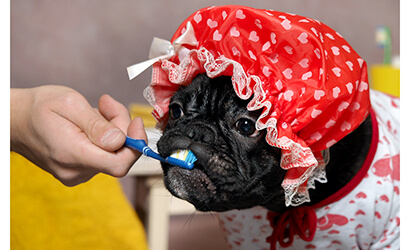
Q: Does it hurt my pet to treat periodontal disease?
A: While some pain may occur for your pet, vets always do everything that they can to ease the discomfort of the experience. They use local anesthetics like novocaine, just as a human dentist might. They will also usually give pain medication as a part of the procedure and give the pet an injection of an anti-inflammatory that lasts a long time after the procedure is done. If you think your pet is still experiencing pain or discomfort after the procedure is complete, contact the vet as they will often prescribe other methods of pain relief.
Q: Can a human toothbrush be used on my pet? Do I need a special pet toothbrush?
A: A smaller toothbrush that can comfortably fit in your pet’s mouth is going to be the most effective and most comfortable for your pet. You can choose a small toothbrush for humans, such as a child’s toothbrush or a toothbrush made specifically for animals. You always need to use soft bristles no matter which kind of toothbrush you choose.
Q: Are knotted ropes, rawhides, or hard rubberized toys good for my pet’s teeth?
A: Knotted ropes, rawhides, and hard rubber toys can benefit your pet’s teeth by helping to remove plaque. It is important that you watch your pet with these items so that they do not break off pieces that can be swallowed and get caught in their intestines. Cow hooves, ice cubes, cooked bones, and other items can be harder than pet’s teeth as well, meaning that your pet could easily break off their teeth while chewing them. For good dental treats and chews for your pets, it is recommended that you use treats such as Greenies.
Q: What is the benefit of a rawhide or chew toy?
A: A chew toy will bring forth saliva, knock off plaque and other material from the teeth and more. That said, flat rawhide will do a better job of cleaning off the teeth than a thick rawhide bone will.
Q: What is the benefit of chlorhexidine in my dog’s dental chews?
A: Chlorhexidine helps to control viruses, fungi, and bacteria in the mouth. It will also inhibit plaque and will work for up to 12 hours. Additionally, it will increase the rate of calculus while it removes plaque. Chlorhexidine is often used as a rinse instead of a toothpaste as some of the common ingredients in toothpaste will cause it to go inactive, and some pets do not enjoy the taste of the chlorhexidine.
Q: Are greenies good for my pet?
A: Anyone who has a dog that essentially swallows a treat or food whole will need to be supervised when they eat these treats. Any undissolved portion of Greenies or any other treat can cause cell death as it compresses the tissues that surround it. Usually, this cell death will happen in the esophagus or in the small intestine. Without getting attention from the vet, this cell death may prove to be fatal. To prevent this from happening, just watch your dog and make sure they aren’t swallowing big pieces whole. Training your dog to eat slowly when they are young is a great way to help prevent this, and giving puppies big knuckle bones will help teach them to gnaw on treats and not try to eat massive chunks.
Q: What benefit does zinc have in an oral product?
A: Zinc can benefit your pet’s mouth by:
- Reducing plaque
- Reducing bad breath
- Stimulating the growth of cells
Q: What is the benefit of enzymes in an oral treat or other product?
A: Enzymes, like lactoperoxidase or glucose oxidase, can help kill the bacteria responsible for the formation of plaque.
Q: What is hexametaphosphate, or HMP?
A: Hexametaphosphate is a compound that interrupts the formation of plaque by sticking the saliva to calcium so that no plaque can harden up into calculus. HMP will also soften the plaque that has already formed on teeth and is often used as the coating on a treat.
Q: Are wipes for teeth effective when caring for the oral health of a pet?
A: While teeth wipes won’t be as beneficial as tooth brushing, they are definitely better than not doing anything at all. The main reason that these wipes aren’t nearly as effective is because they do not reach under the gum line where there is the highest concentration of bacteria.
Questions about non-anesthetic dental procedures
Q: How is it possible to clean a cat or dog’s teeth while it is moving and under stress?
A: Vets will sit at eye-level with the cat or dog and restrain them to keep the patient comfortable and calm. Pets are never bullied or forced into submission. Most animals will become compliant fairly quickly after the procedure begins.
Q: Do pets panic and become frightened when a vet tries to use a motorized polisher or a scaler?
A: Vets will treat their patients just as a human dentist will treat a child who is going to the dentist for the first time. Patience is important, and slowly moving through each stage of the procedure helps. Vets will also work to build trust so that the cats and dogs will let them use all of the necessary tools needed to complete the job without the animal getting worked up.
Q: Does this technique work with patients considered high risk?
A: Yes. Dental cleanings that do not use anesthesia can be better for older pets and for those pets that have heart disease, kidney disease, or liver disease that are not a great fit for general anesthesia.
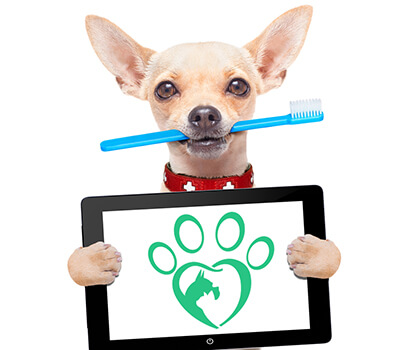
Q: Can a trained, NAD or non-aesthetic dental hygienist conduct a cleaning on any dog?
A: No. Even though the large majority of cats and dogs will benefit from dental procedures without anesthesia, there are a few pets for which it is not appropriate. Pets who are not good candidates for non-aesthetic dental work include cats and dogs with inflamed stomachs, fractured teeth, caries, or severe gingivitis. When hygienists find a fractured or loose tooth, gum disease, abscesses, tumors, epulis, or other conditions that need a doctor’s help, they will bring it to the vet’s attention. When using procedures that eliminate anesthesia are not appropriate for the specific pet, the pet will be referred to traditional anesthetic methods after the drug-free approach has first been tried.
Q: What will the hygienist do if the pet is too afraid, aggressive, or totally uncooperative?
A: A hygienist experienced in non-anesthetic procedures will be able to tell within just a few minutes whether or not the patient is going to allow a successful procedure to take place. In some cases, they will be able to calm these pets down to give them a total cleaning; however, in other cases, it will be determined that the patient possesses a temperament not suited for a treatment without anesthesia.
While getting your pet’s teeth cleaned can seem troublesome, there is no need to fear the procedures. They are routine and common, meaning that your veterinary professional or veterinary dentist is well-versed in what it takes to make your pet comfortable and at ease before, during, and after the procedures. There are other measures you can take at home that will help you to lessen the need for invasive procedures and help prevent periodontal disease as well, such as certain toys, treats, tooth brushing, and more. Simply refer to this article anytime you are feeling unsure about the health of your pet’s mouth, or contact your veterinarian for more specific information.
